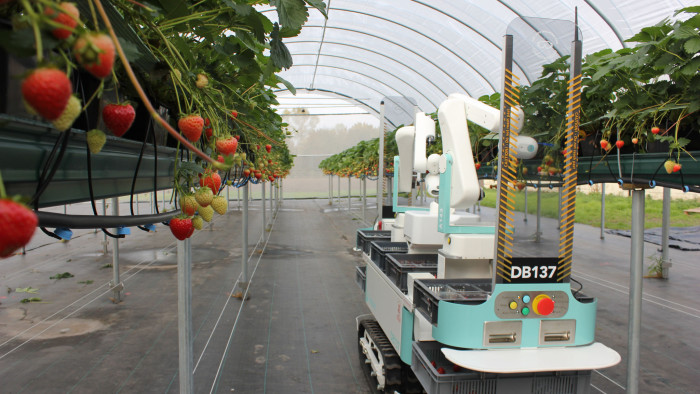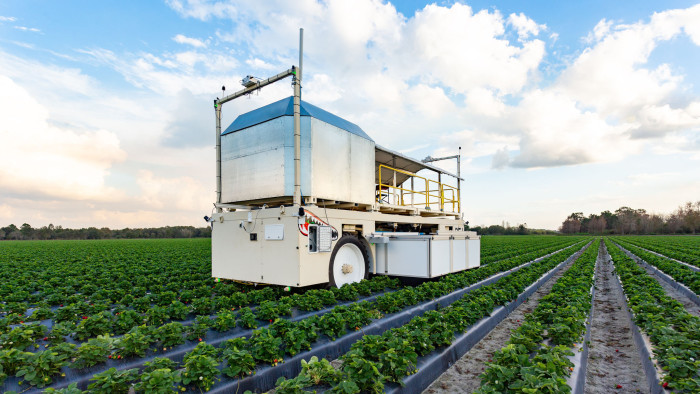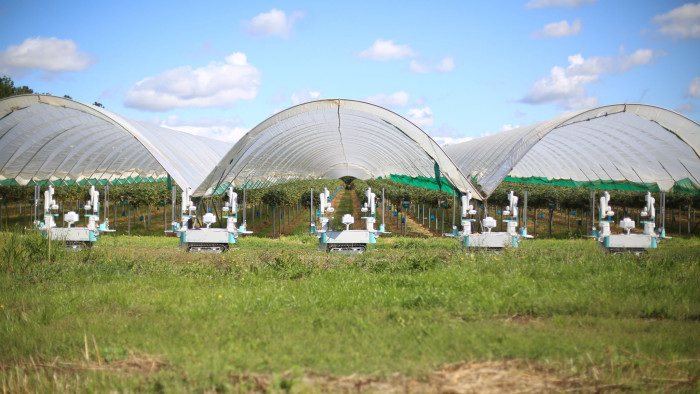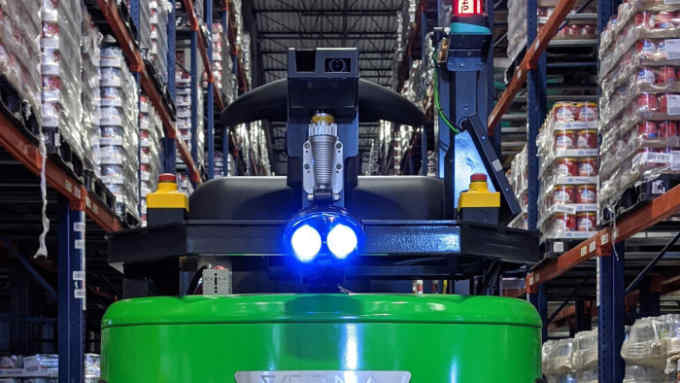Coronavirus accelerates the rise of the robot harvester

Roula Khalaf, Editor of the FT, selects her favourite stories in this weekly newsletter.
When UK farmers found themselves short-staffed due to Covid-19 travel restrictions, the government launched a campaign urging the public to cover the shortfall and “Pick for Britain”.
With the recruitment campaign struggling to convert applicants into farm workers and Brexit already disrupting the supply of staff, growers are turning to robotic harvesters as a long-term solution to the labour gap.
But while promising prototypes are being tested, farmers still need a reliable harvesting workforce because so much of their capital is invested in the earth.
“As soon as your crops are planted, your cash is in the ground and you have got to get it back. If you do not, you face disaster,” says Simon Pearson, director of the University of Lincoln’s Institute of Agri-Food Technology.
Already some growers are changing their planting habits to account for the labour risk. Pollybell, a 5,000-acre mixed organic farm near Doncaster in the north of England, ceased producing tenderstem broccoli this year because it could not guarantee it could recruit the 50 people needed to harvest the high-value crop.
“The real solution [to the labour shortage] needs to be designing systems and investing in the technology to solve it,” says James Brown, Pollybell director.
A UK consortium — backed by growers and co-ordinated by the University of Lincoln and others — is accelerating certain robotics and automation projects in an effort to counter farm labour shortages.
Dogtooth Technologies, a Cambridge-based robotics company, runs one of six projects the consortium has chosen for acceleration, specifically its prototype strawberry harvester. “We are finishing final trials and proving the commercial viability, and then we are ready to start scaling manufacture,” says Ed Herbert, Dogtooth founder and chief operating officer.
Cameras on robotic arms scan for fruit, estimate its 3D location and assess whether each is ready to be picked. The berry is then sent to an inspection chamber and assessed for ripeness, defects and mass, then sorted into the appropriate punnet.
One worker can manage a dozen Dogtooth machines, each picking at half the rate of a human, says Mr Herbert.
In the US, Harvest Croo Robotics is testing its Berry 6 autonomous machine that sports 16 robotic heads, each with six arms that scan, select and pick three berries every 10 seconds. The harvester takes 20 hours to pick what 30 humans can gather in a day, says Joseph McGee, chief executive. “It still has improvements to be made but it is capable of going into the field and picking,” he says.

Strawberries have proved a popular testing ground for robotics companies, as soft-fruit picking is high-value work and the long season means machines will be used widely, says Mr Herbert.
Robots are also being used to pick other crops. Mr Brown has developed a broccoli harvester at Pollybell, for example, while researchers at Cambridge university have built a prototype that can find and pick lettuce heads, says Fumiya Iida, principal investigator at the university’s Bio-inspired Robotics Lab.
Navigating hurdles such as funding and regulation will dictate how — and how fast — robotic harvesters are developed for commercial use, as well as the types of business models employed.
Mr Herbert says Dogtooth’s machines are designed for growers to purchase and repair or replace if they break. Harvest Croo, on the other hand, plans to build a fleet of machines that it will manage and run, making them a “drop-in replacement for the labour pool”, Mr McGee says.

But even if such technology is established, human supervisors will be needed to manage robots rather than do the picking, says Vishwanathan Mohan, a lecturer at Essex university. “This is going to give more high-skilled employment to people . . . working on the farm instead of doing this repetitive, laborious task for which the financial reward is almost nothing,” he says.
Opinions vary on how long it will be before robots are adopted widely. “If we really push it hard . . . and get a proof of concept this season, we could have commercial robots next season,” says Prof Pearson of the University of Lincoln.
Others are more sceptical: while there are promising prototypes, a decade is “not very unreasonable as a timeline”, says Stavros Vougioukas, associate professor at the department of Biological and Agricultural Engineering at University of California Davis.
What most experts can agree on is that robots will be plugging a shortage, rather than taking jobs. “First-world economies just do not pick their own fruit and vegetables,” says Ali Capper, chairman of the National Farmers Union Horticulture and Potatoes board, because such roles are temporary and seasonal. “It is very hard to live in a first-world economy and depend on a job like that.”

Comments